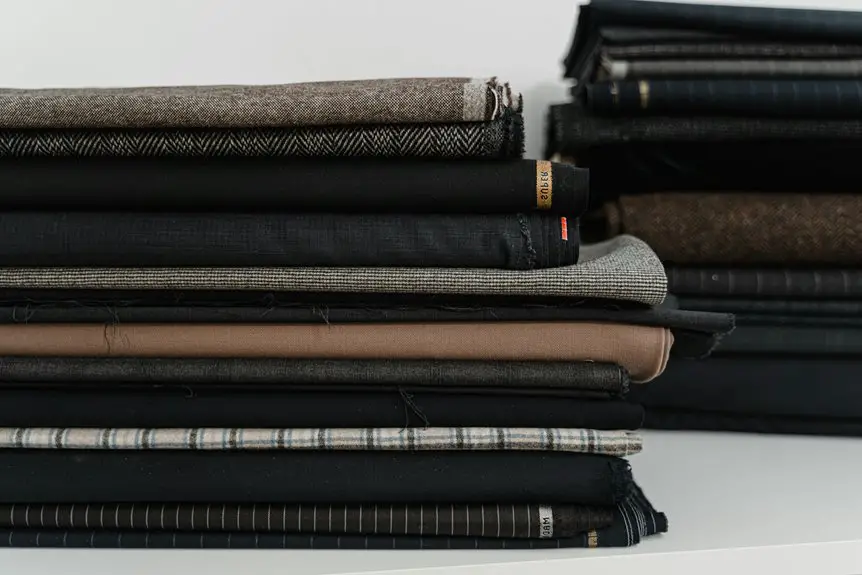To measure fabric shrinkage accurately, first cut a sample to a standard size. Wash and dry it following care instructions, ensuring you use the same temperature and method you plan to use in practice. Measure the original length, then measure again after laundering. Use the shrinkage percentage formula to calculate the size loss: (Original Length – Shrunk Length) / Original Length × 100. Understanding this process can help you make informed choices about fabric care and selection.
Table of Contents
Key Takeaways
- Prepare fabric samples according to standardized dimensions to ensure consistency in measurements before and after laundering.
- Use a reliable ruler or measuring tape for accurate pre-wash and post-wash length measurements.
- Subject samples to recommended laundering processes, including specific wash and drying methods.
- Calculate shrinkage percentage using the formula: (Original Length – Shrunk Length) / Original Length × 100.
- Record all measurements and procedures in a notebook or digital device for thorough analysis and future reference.
Understanding Fabric Shrinkage
When you wash and dry your fabrics, you might notice they don’t always retain their original size. This change, known as fabric shrinkage, occurs due to various factors, including the type of fibers, the fabric’s weave, and the washing method.
Natural fibers like cotton and wool are more prone to shrinking than synthetic ones. Shrinkage happens when fibers relax during washing, causing them to contract. You’ll see this effect more with high temperatures and aggressive cycles.
Understanding fabric shrinkage helps you choose the right washing settings and care methods to minimize size loss. Pay attention to the fabric content and follow care instructions closely to maintain your items’ shape and fit over time.
Standardized Testing Methods
To accurately measure fabric shrinkage, standardized testing methods provide a reliable framework. These methods guarantee consistency and comparability across different fabrics and production batches.
You’ll want to follow established standards, like ASTM D 1513 or AATCC 135, which outline specific procedures for testing shrinkage. By adhering to these guidelines, you can minimize variables that might skew your results.
Begin by preparing your fabric samples according to the specified dimensions and conditions. Then, subject them to the recommended laundering process, including wash cycles and drying methods.
Afterward, measure your samples accurately before and after the laundering process. This structured approach not only enhances your credibility but also provides a benchmark for quality control in your fabric production.
Calculating Shrinkage Percentage
Calculating shrinkage percentage is essential for understanding how much a fabric may alter after washing. To determine this, you can follow a simple formula:
[ text{Shrinkage Percentage} = left( frac{text{Original Length} – text{Shrunk Length}}{text{Original Length}} right) times 100 ]
Let’s break it down with an example:
| Original Length (inches) | Shrunk Length (inches) |
|---|---|
| 60 | 58 |
| 40 | 39 |
| 30 | 29 |
| 50 | 48 |
Using our formula, you can calculate the shrinkage for each sample. This simple method helps you gauge how much to adjust your patterns or expectations in future projects.
Factors Influencing Shrinkage
Understanding shrinkage percentage is just the first step; several factors can greatly influence how much a fabric shrinks.
You need to take into account these key elements:
- Fabric Composition: Natural fibers like cotton and wool tend to shrink more than synthetic fibers such as polyester. The material’s structure plays an essential role.
- Washing Temperature: Hot water can cause fibers to contract, leading to increased shrinkage. Always pay attention to the washing instructions for your fabric.
- Drying Method: High heat during drying can exacerbate shrinkage. Air drying is often gentler on fabrics and can help maintain their original size.
Tools and Equipment for Measurement
Having the right tools and equipment can make measuring fabric shrinkage a straightforward process.
Start with a reliable ruler or measuring tape to guarantee accurate measurements before and after washing. A digital scale can help you weigh the fabric, providing exact weight measurements necessary for precise calculations.
You’ll also need a washing machine and dryer to subject the fabric to typical conditions it’ll face. For best results, consider using a fabric swatch cutter to create uniform samples.
A notebook or digital device is handy for recording your measurements. Finally, a steam iron can help you smooth out wrinkles before measuring, guaranteeing you get the most accurate results.
With these tools in hand, you’re set for an effective shrinkage assessment.
Industry Standards and Best Practices
When it comes to measuring fabric shrinkage, adhering to industry standards and best practices guarantees reliable results. You want to make sure your measurements are accurate and consistent, which helps in quality control and product reliability.
Here are three key practices to follow:
- Test Samples: Always use a representative sample of the fabric to measure shrinkage, as different sections may behave differently.
- Standardized Conditions: Conduct your tests under controlled conditions, including the same temperature, humidity, and wash cycles, to maintain consistency.
- Document Procedures: Keep detailed records of your measurements, methods, and any deviations from standard practices to help identify trends or issues over time.
Following these guidelines will help you achieve more precise and trustworthy results in your shrinkage measurements.
Frequently Asked Questions
What Types of Fabrics Shrink the Most?
When it comes to fabrics, cotton and wool tend to shrink the most. You’ll notice significant changes in size after washing and drying, especially if you use high heat. Always check care labels before laundering!
How Can I Prevent Shrinkage in My Garments?
You’d think avoiding shrinkage is simple, right? To keep your garments intact, wash them in cold water, air dry, and avoid high heat. But then again, who doesn’t love a surprise mini wardrobe?
Does Pre-Washing Fabric Help Reduce Shrinkage?
Yes, pre-washing fabric can help reduce shrinkage. It relaxes the fibers, allowing them to shrink before you sew. You’ll have a more stable fabric for your projects, minimizing surprises after you’ve finished your garment.
How Often Should I Test for Shrinkage?
Testing for shrinkage is like checking the weather; you should do it regularly, especially with new fabrics or after washing. It helps you anticipate changes and guarantees your projects remain as intended.
What Are the Consequences of Excessive Shrinkage?
Excessive shrinkage can lead to ill-fitting garments, reduced comfort, and compromised appearance. You might find yourself frequently replacing clothes or adjusting them, which can be frustrating and costly in the long run.
- How to Measure Fabric Shrinkage Accurately? - June 9, 2025
- Can Fabric Conditioner Help Unshrink Clothes? - June 9, 2025
- The Role of Agitation in Fabric Shrinkage - June 9, 2025




